Expectations for Stock Market Decline Not Unreasonable and Even Prudent
Stock-Markets / Stock Markets 2013 May 13, 2013 - 12:46 PM GMTBy: Andre_Gratian
 Current Position of the Market
Current Position of the Market
SPX: Very Long-term trend - The very-long-term cycles are in their down phases, and if they make their lows when expected (after this bull market is over), there will be another steep decline into late 2014. However, the severe correction of 2007-2009 may have curtailed the full downward pressure potential of the 40-yr and 120-yr cycles.
Intermediate trend - SPX has again delayed is intermediate correction. A new potential target price provided by P&F chart analysis has been set for the top.
Analysis of the short-term trend is done on a daily basis with the help of hourly charts. It is an important adjunct to the analysis of daily and weekly charts which discusses the course of longer market trends.
TECHNICAL COMMON SENSE
Market Overview
The first thing to remember is that, however strong they appear to be, market trends do not last forever! If there is one thing that characterizes the stock market behavior, it is "fluctuation". With this fact in mind, and realizing that we are in an extended uptrend which has yet to see a decent correction after 25 weeks and 292 points in the SPX, it is time for a noteworthy fluctuation to occur. Are there signs that this will be sooner rather than later?
First of all, let's list the main reasons why the coming correction will not be a major one: 1) The SentimenTrader is still neutral. Normally, at important tops, it shows excessive optimism. This index has an excellent track record and it does not currently foresee anything devastating on the horizon.
2) There is a flagrant lack of deceleration in the major indices. They are still hitting the top of their main channels. The 2000 top and the 2007 top both show stock prices going essentially sideways for two or three months before a substantial decline sets in. Intermediate tops, however, do not need such a period of distribution. They can sometimes reverse on a dime. I suspect that the intermediate reversal which is ahead of us will take that form. So do we have reasons to think that this reversal is imminent, perhaps only a few days ahead? The answer is yes, and I will list them below:
Structure: Most EW analysts agree that we are in an extended wave 5 of the trend which started at 1343 in the SPX. Within that wave 5, we are most likely in minute wave 3, which could have topped on Thursday at 1635. If it has, minute wave 4 could bring a correction of 15 to 25 points before minute wave 5 of minor 5 gets under way. When minute wave 5 is complete, it will not only complete minor wave 5, but intermediate wave 3 as well. If so, it has the potential of bringing about the most significant correction since 1267 on June 4, 2012. The alternative is that minute wave 3 is not complete, but will be shortly. This is how Tony Caldaro labels the phases and Tony has been right since the beginning of the bull market in March 2009.
Cycles: There are some important cycles due to make their lows in the first week of June. They will be detailed later on. They should have some influence on the market commensurate with their stature. It is very possible that they could cause the reversal that is anticipated in the SPX after it has completed minor wave 5 from 1343.
P&F projection: We are approaching maximum projections obtained from the base created above the 1536 low. When SPX consolidated above 1580, some confirming counts were formed which agree with those of the lower base and add to their validity.
Resistance zone: On Thursday, SPX bumped against the top of the channel from 1343. That alone should cause a pull-back which may have started (but is not complete) and if Thursday was the top of minute wave 3. I can also draw two major internal trend lines dating from the 1075 low which intersect precisely at the same level and which could (should) bring additional resistance to higher prices.
These are the major points in favor of an important correction which could start within days. Let's see if they can be substantiated by some additional data as we pursue our detailed analysis.
Chart Analysis
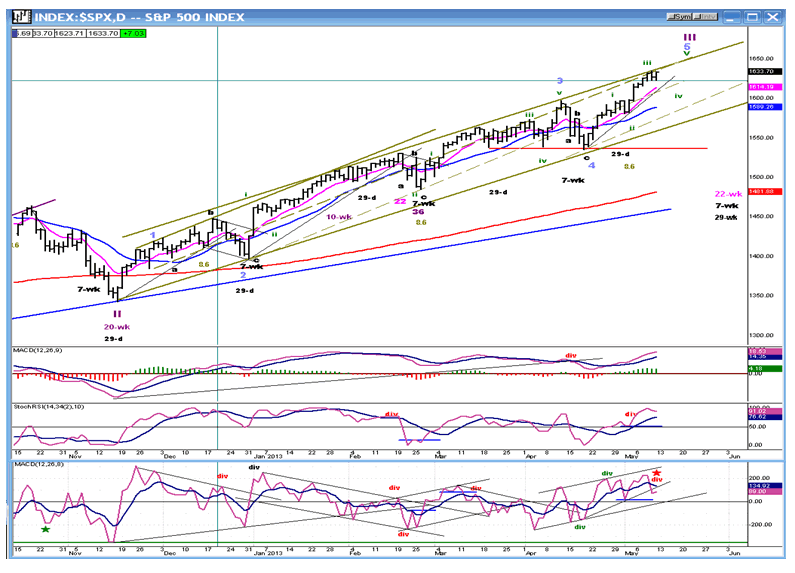
The daily SPX chart above (courtesy of QChart) contains some pertinent information which will help us to gauge the market position. The EW labeling (courtesy of Tony Caldaro) shows that we may just have completed wave iii of 5 (from 1536) on Thursday. If so, we should continue our pull-back from 1635 early next week. After completing wave iv and wave v (hopefully in the next few days because of the cycles that are lurking around the first of the month), we should experience the most important correction since 1343. There is a good chance that we have started wave iv for the reasons given earlier, i.e. the resistance from the top of the channel and from major internal trend lines and parallels which are not shown on this chart.
Let's now look at the indicators and examine them, starting from the top. The MACD is still moving up, but the histogram has started to lose its amplitude. That could be a sign that the top line may be about to roll over. In the next one below (SRSI) the top line has started to turn down and may or may not continue and give a sell signal, depending on what price does. The lowest one is the most telling! It turned down hard on Thursday, but barely moved up on Friday as the market rallied to close near its high. That's a sign of divergence -- or incipient weakness -- which always shows up first in this (breadth) indicator. It warns us that wave iii may have topped Thursday or, if not, will do so very soon.
And why do we HAVE to turn down soon? Look at the cycles which are due in the first week of June! You can see what happened when the 22-wk and 7-wk cycles bottomed. The last time the 29-wk cycle made its low was at 1075. Of course, you have to take all cycles with a grain of salt. They often occur in cluster and do not always bring to bear the same pressure on the market. In this case, however, considering the make-up of the coming cluster, I would expect a good pull-back into that time frame. The correction does not have to stop there, as there are more cycles ahead capable of continuing the decline into July.
One more note: the blue trend line just before the 200-DMA (red) connects 1075 to 1343. As of Friday, it ran at about 1460, which is about 2/3 of the way down from the top of the uptrend. The 200-DMA, just above, runs just a little above 50%. Therefore, if we do have a correction as intermediate wave 4, it is conceivable that we could retrace down to one of these levels, especially since the first good support occurs at 1474 -- the top of the November 2011 high. Of course, that would require decisively breaking below the strong 1539 support level.
I have presented a lot of assumptions for a potential scenario, and it would be a miracle if they all turned out to be correct! But the title of this letter is "Technical Common Sense" and nothing that I have said ventures outside of that realm. The suppositions create a chain of events, each one representing a link, so for it be become reality, each link needs to be realized. Some adjustments will most likely have to be made along the way.
Cycles
On the chart, I have shown some cycle sequences leading to those bottoming in early June. They have been gathered over the course of the time I have been studying the market. Erik Hadik has been responsible for pointing out most of them.
The 66-wk cycle has a very regular phase and has probably been largely responsible for the strength behind this uptrend since 12/31/12. Its half-phase, the 33-wk cycle, bottoms in July and could be a factor in prolonging the decline which is about to start.
Breadth
The breadth indicators have moved up along with the market and the McClellan oscillator has turned down with Thursday's correction. Like my own A/D indicator, it only went sideways on Friday, a sign of divergence. Also, note that this indicator is at a level from which it normally reverses and, when it does, it tends to continue down
The NYSI also moved up to a marginal new high, thus invalidating the negative divergence which it had created at the former top. Its RSI has now reached overbought status, but could trade for a little while in that zone before turning down.
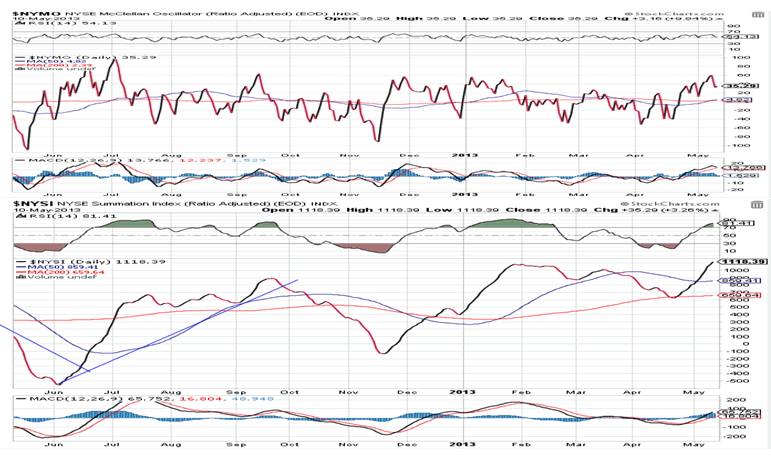
Sentiment Indicators
For the third consecutive week, the SentimenTrader (Courtesy of same) remains neutral, although it moved just a little closer to the red segment. If it continues to crawl up over the next few days, I will feel a lot better about the potential scenario that I depicted above.
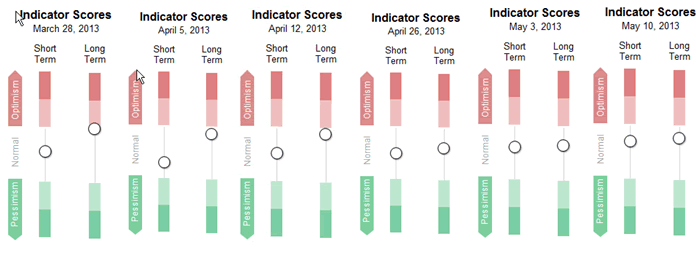
VIX
The rounding, saucer-like pattern which appears in the VIX at market tops continues to form. It will be complete when the index moves up sharply in a sustainable trend, overcoming the previous short-term highs and staying above its 200-DMA.
Along with the formation of that pattern, positive divergence continues to increase, meaning that instead of making lower lows as the market makes higher highs, the index has been making a series of higher lows instead. This pattern started in March and VIX is now forming its third higher low since that date. This is much longer than the last two similar patterns identified on the chart.
A sign that this may be about to end is that the indicator is very oversold and should turn up shortly from that position, as it has done in the past. Its turning up corresponds to the market stalling and starting to reverse. The last two times only brought brief spikes followed by an immediate retracement, as the market only corrected briefly before turning up again. Because of the technical conditions stated above, this time could be different and lead to a more sustained advance in the VIX, as the market starts a more important correction.
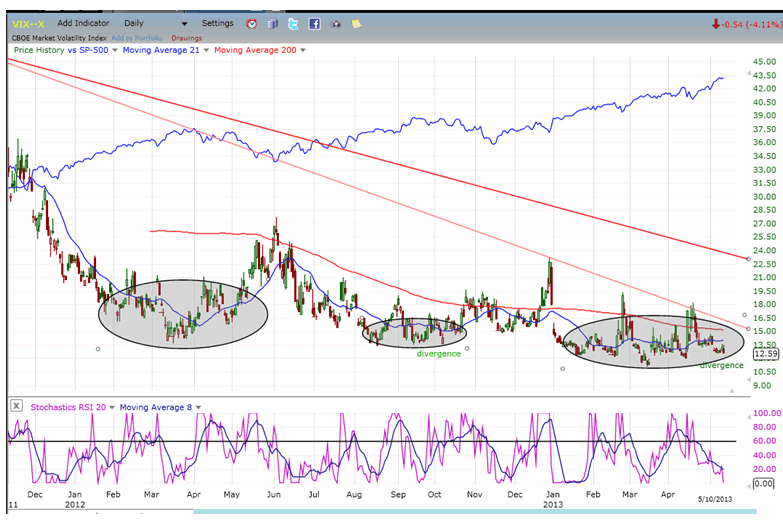
XLF (Financial SPDR)
The financial index continues to move in concert with SPX with no relative weakness showing. However, the indicator is overbought and may be ready to correct since the P&F chart indicates that 19 is a phase count which should cause a normal pull-back after it has been reached.
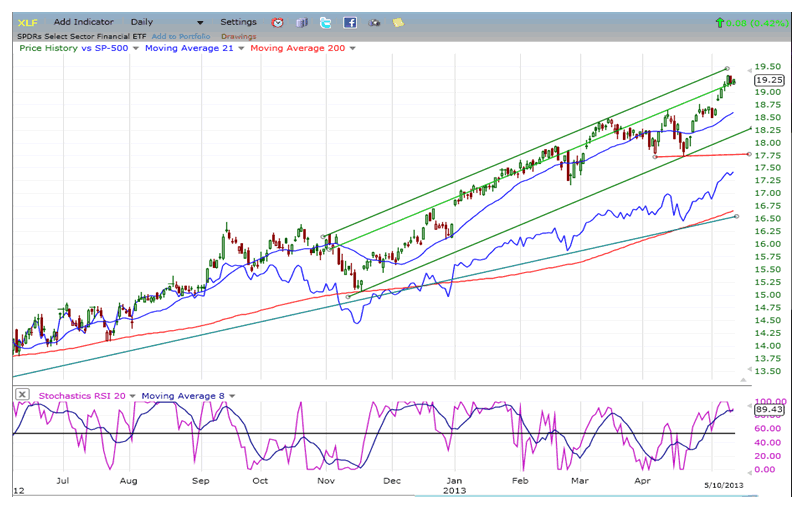
BONDS
As we can see on the chart, TLT tends to go against SPX, but it does not do so consistently. This time, it must have been anticipating that SPX would already be in a corrective mode, because it started its uptrend a couple of months ago. Since SPX did not oblige, it is now going in the opposite direction, which is what one would expect.
TLT is not really the best leading index and, regardless of what SPX does, TLT actually follows its own path. After peaking at an all-time high, it had an extended correction which may have ended recently with a move out of the corrective channel. It is in the process of correcting that initial break-out and has pulled back a little more than .618 of its advance. Extending that short-term correction would be a sign of weakness and bring into question whether it will be able to come out of the larger channel or remain in a longer-term corrective mode. It is in a support zone and what it does from this point on will give us some clues about its longer-term intentions.
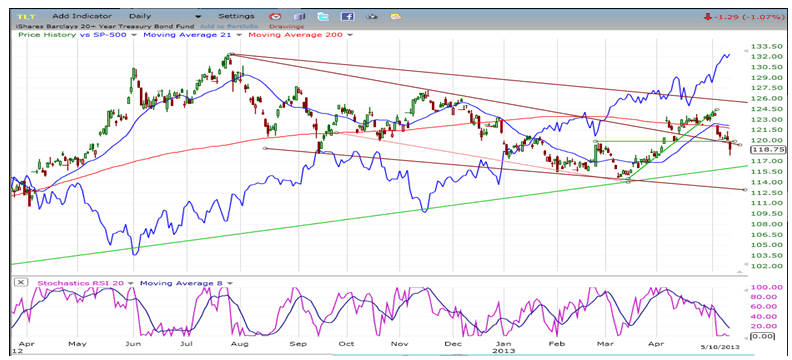
GLD (ETF for gold)
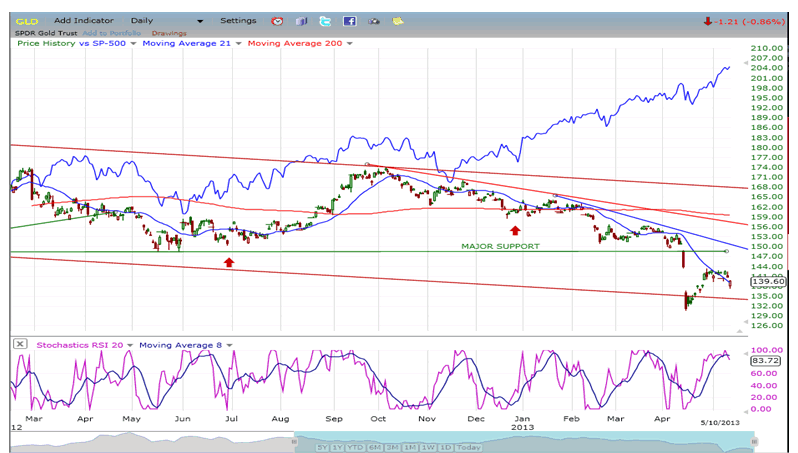
If there is only minimal consistency of behavior between TLT and SPX, there is even less in GLD. This is evident on this chart. Between June and October, GLD and SPX were in sync. Since then, after a brief period of togetherness, they went in opposite directions. After its sharp drop, GLD should either consolidate before going lower, or build a base which would be required before attempting to end its long-term correction and resume its long-term uptrend. The P&F chart has a count to 127 which may be met or not. GLD should be given some time to decide what it wants to do from here, keeping in mind that its 25-wk cycle low is not too far ahead.
UUP (dollar ETF)
After correcting its previous advance and finding support where it should have, last week UUP had a strong move back to the level of its previous short-term top. This probably indicates that the correction is over and that the index is ready to extend its uptrend. I stated earlier that it had a projection to about 23.30. Resumption of the uptrend will have to be confirmed with some follow-through strength that will move it above the 22.70 level.
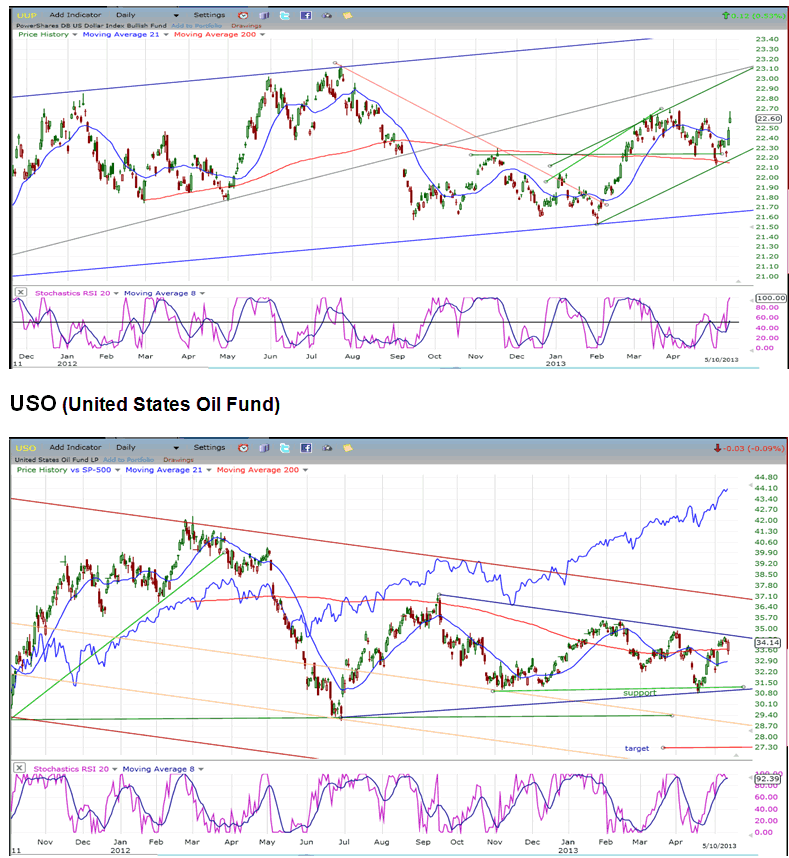
Last week, I suggested that USO might be extending its triangle formation. This is still possible since it has continued to trade within the confines of the converging trend lines. USO does show a fairly reliable propensity to move in sync with SPX. Except for the last 3 months, it was following the latter perfectly. We may therefore tentatively assume that when SPX corrects, USO will decline as well and move below the lower triangle trend line.
Summary
By using several complementing methodologies to analyze the market position, I have shown that expecting a decline over the near term is not unreasonable, and perhaps even prudent. Let's see if the analysis proves to be correct.
FREE TRIAL SUBSCRIPTON
If precision in market timing for all time framesis something that you find important, you should
Consider taking a trial subscription to my service. It is free, and you will have four weeks to evaluate its worth. It embodies many years of research with the eventual goal of understanding as perfectly as possible how the market functions. I believe that I have achieved this goal.
For a FREE 4-week trial, Send an email to: ajg@cybertrails.com
For further subscription options, payment plans, and for important general information, I encourage
you to visit my website at www.marketurningpoints.com. It contains summaries of my background, my
investment and trading strategies, and my unique method of intra-day communication with
subscribers. I have also started an archive of former newsletters so that you can not only evaluate past performance, but also be aware of the increasing accuracy of forecasts.
Disclaimer - The above comments about the financial markets are based purely on what I consider to be sound technical analysis principles uncompromised by fundamental considerations. They represent my own opinion and are not meant to be construed as trading or investment advice, but are offered as an analytical point of view which might be of interest to those who follow stock market cycles and technical analysis.
Andre Gratian Archive |
© 2005-2022 http://www.MarketOracle.co.uk - The Market Oracle is a FREE Daily Financial Markets Analysis & Forecasting online publication.



